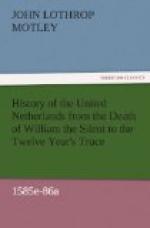Certainly the mass of misdemeanours and infamies hurled at the head of the favourite by that “green-coated Jesuit,” father Parsons, under the title of ‘Leycester’s Commonwealth,’ were never accepted as literal verities; yet the value of the precept, to calumniate boldly, with the certainty that much of the calumny would last for ever, was never better illustrated than in the case of Robert Dudley. Besides the lesser delinquencies of filling his purse by the sale of honours and dignities, by violent ejectments from land, fraudulent titles, rapacious enclosures of commons, by taking bribes for matters of justice, grace, and supplication to the royal authority, he was accused of forging various letters to the Queen, often to ruin his political adversaries, and of plottings to entrap them into conspiracies, playing first the comrade and then the informer. The list of his murders and attempts to murder was almost endless. “His lordship hath a special fortune,” saith the Jesuit, “that when he desireth any woman’s favour, whatsoever person standeth in his way hath the luck to die quickly.” He was said to have poisoned Alice Drayton, Lady Lennox, Lord Sussex, Sir Nicholas Throgmorton, Lord Sheffield, whose widow he married and then poisoned, Lord Essex, whose widow he also married, and intended to poison, but who was said to have subsequently poisoned him—besides murders or schemes for murder of various other individuals, both French and English. “He was a rare artist in poison,” said Sir Robert Naunton, and certainly not Caesar Borgia, nor his father or sister, was more accomplished in that difficult profession than was Dudley, if half the charges against him could be believed. Fortunately for his fame, many of them were proved to be false. Sir Henry Sidney, lord deputy of Ireland, at the time of the death of Lord Essex, having caused a diligent inquiry to be made into that dark affair, wrote to the council that it was usual for the Earl to fall into a bloody flux when disturbed in his mind, and that his body when opened showed no signs of poison. It is true that Sir Henry, although an honourable man, was Leicester’s brother-in-law, and that perhaps an autopsy was not conducted at that day in Ireland on very scientific principles.
His participation in the strange death of his first wife was a matter of current belief among his contemporaries. “He is infamed by the death of his wife,” said Burghley, and the tale has since become so interwoven with classic and legendary fiction, as well as with more authentic history, that the phantom of the murdered Amy Robsart is sure to arise at every mention of the Earl’s name. Yet a coroner’s inquest—as appears from his own secret correspondence with his relative and agent at Cumnor —was immediately and persistently demanded by Dudley. A jury was impannelled—every man of them a stranger to him, and some of them enemies. Antony Forster, Appleyard, and Arthur Robsart, brother-in-law and




